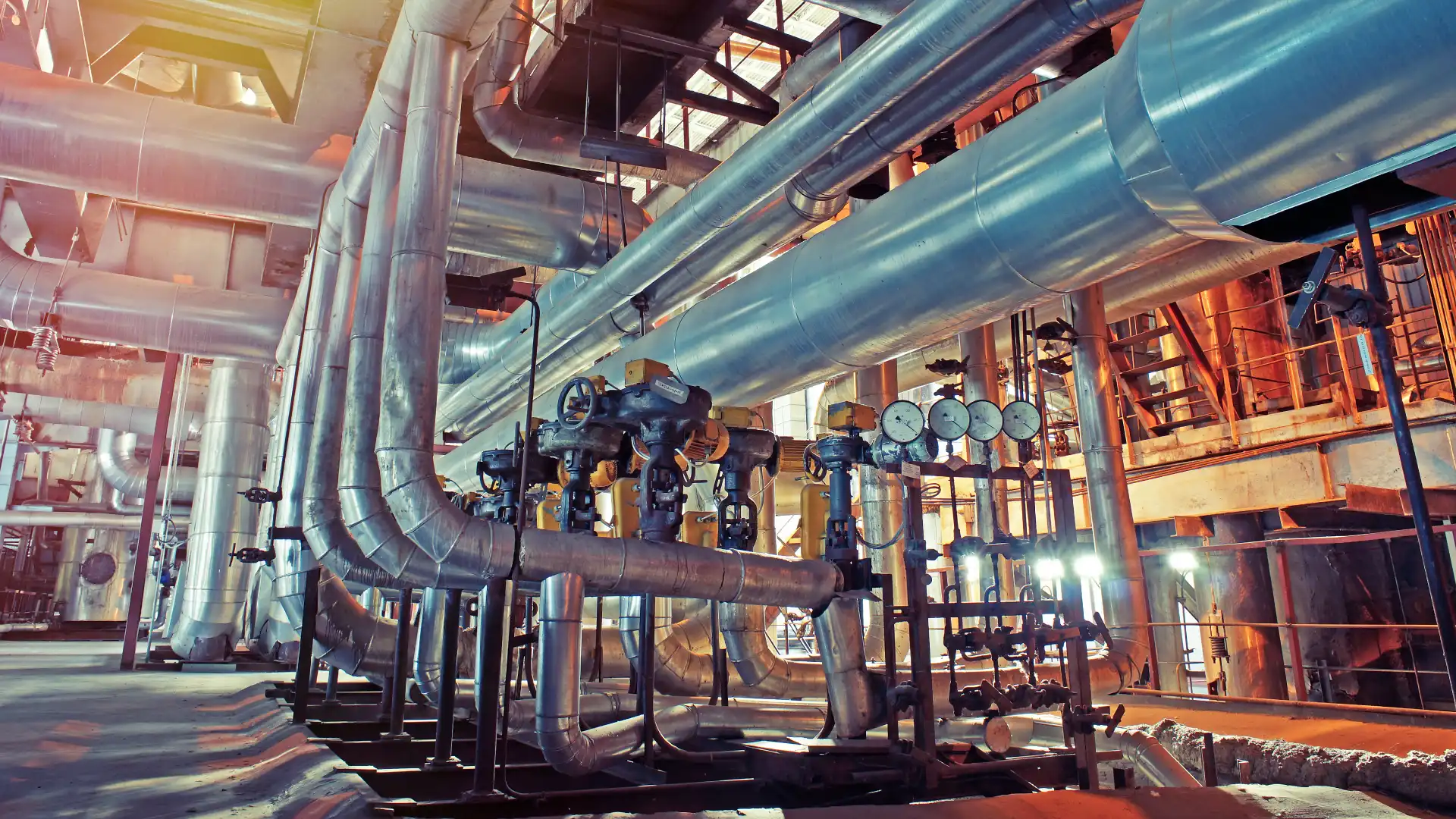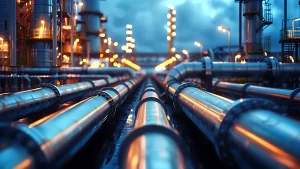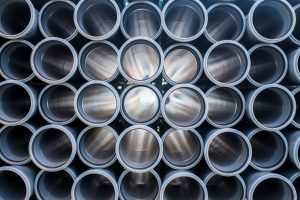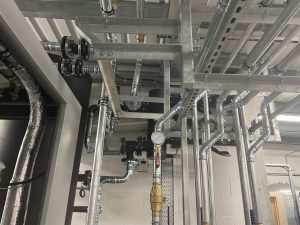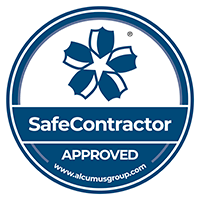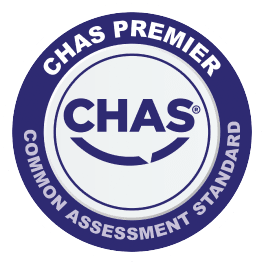Industrial pipework is the backbone of countless facilities across the UK, transporting essential fluids for everything from powering machinery to heating buildings. However, even the most robust systems can encounter problems. Here, we’ll delve into some common industrial pipework issues encountered in British industry and explore troubleshooting techniques to get your operations back on track.
Leaks
Leaks are a frequent foe, leading to wasted product, environmental concerns, and potential safety hazards.
- Signs: Be on the lookout for damp patches, puddles, or unusual water meter readings. Hissing noises may also indicate a leak under pressure.
- Troubleshooting: For minor leaks, tightening joints with spanners or applying repair clamps might suffice. If the leak persists or is more substantial, isolate the affected section by closing the relevant valves. This will minimise product loss and allow for safe repairs. At this point, call a qualified pipework contractor for repairs or replacement of the damaged section.
Blockages
Clogged pipes can disrupt flow and hinder production.
- Signs: Reduced pressure, unusual noises emanating from the pipes, and slow-draining equipment are all potential indicators of a blockage.
- Troubleshooting: For non-hazardous materials, snaking the line with a drain snake or using high-pressure water jetting techniques (hydrojetting) might dislodge the blockage. However, ensure you have the appropriate safety gear for hydrojetting, as the high-pressure water can be dangerous. For tougher clogs or blockages involving hazardous materials, consult a professional for specialised cleaning methods that comply with health and safety regulations (HSE regulations) in the UK.
Corrosion
Over time, pipes can deteriorate due to exposure to harsh chemicals, temperature extremes, or improper materials selection during installation.
- Signs: Visible rust, flaking on the pipe’s surface, leaks, and reduced flow are all indications of corrosion.
- Troubleshooting: Regular inspections and preventative maintenance are key. Implementing a preventative maintenance programme can help identify early signs of corrosion before it becomes a major issue. In some cases, applying protective coatings or liners can extend pipe life. Severely corroded pipes may require replacement with pipes made from a more suitable material for the application. When replacing pipes, ensure they comply with relevant British Standards (BS) specifications.
Water Hammer
This phenomenon occurs when a sudden change in flow creates a pressure surge, potentially damaging pipes and joints. It’s also known as hydraulic shock.
- Signs: Loud banging noises within the pipes are the telltale sign of a water hammer.
- Troubleshooting: Installing pressure relief valves or water hammer arrestors can help dampen these surges. Ensuring proper valve closure procedures are followed – slow, controlled closure is key – and maintaining a consistent flow rate can also mitigate the risk of water hammer. When installing new pipework or modifying existing systems, consider consulting a pipework design engineer to ensure the system is designed to minimise the risk of water hammer.
- Excessive Vibration: Constant vibrations can loosen connections and lead to premature pipe failure.
- Signs: Visible shaking in the pipes or noticeable noise can indicate excessive vibration.
- Troubleshooting: Identifying the source of the vibration is crucial. Common causes include unbalanced pumps, loose pipe supports, or misaligned equipment. Techniques like using flexible pipe couplings or adding vibration dampeners can address the issue. It’s important to use vibration dampeners that are compliant with relevant British Standards.
Additional Considerations for British Industry:
- Compliance with Regulations: Industrial pipework in the UK must comply with various regulations, including the Health and Safety at Work Act (HSWA) and the Control of Substances Hazardous to Health (COSHH) Regulations. When troubleshooting pipework problems, ensure any work undertaken adheres to these regulations to protect the safety of workers and the environment.
- Material Selection: Consider the specific fluids being transported when selecting pipe materials. British Standards (BS) offer guidance on suitable materials for different applications. For example, BS EN 10025 covers steel pipes for pressure purposes.
- Water Regulations: If your pipework system carries potable water, it must comply with the Water Supply (Water Fittings) Regulations and Advice Note 1 from the Drinking Water Inspectorate (DWI).
Preventative Maintenance is Key
By understanding these common problems and taking a proactive approach to maintenance, you can ensure your industrial pipework system functions smoothly and efficiently. Here are some additional tips for preventative maintenance:
- Regular Inspections: Schedule regular inspections of your pipework system by qualified personnel to identify any potential problems early on.
- Cleaning and Flushing: Periodically clean and flush your pipework system to remove any build-up of debris that could lead to blockages.
- Record Keeping: Maintain detailed records of inspections, maintenance performed, and any repairs or replacements made to your pipework system. This will help you identify trends and potential issues over time, allowing for more informed maintenance decisions.
Partnering with a Qualified Pipework ContractorFor complex repairs, situations involving hazardous materials, or when specialist knowledge is required, partnering with a qualified and experienced industrial pipework contractor is crucial. They can provide valuable expertise in:- Leak Detection: Contractors can employ sophisticated leak detection equipment, such as acoustic leak detectors or thermal imaging cameras, to pinpoint the exact location of leaks, even those buried underground or concealed within walls.
- Pipe Relining: In some cases, rather than replacing a corroded pipe entirely, it may be possible to reline the existing pipe with a new lining material. This can be a more cost-effective and less disruptive option.
- Non-Destructive Testing (NDT): NDT techniques, such as radiography or ultrasonic testing, can be used to assess the internal condition of pipes without causing damage. This can be helpful in identifying potential problems before they become critical.
- Material Selection and Compliance: Contractors can advise on the most suitable pipe materials for your specific application, ensuring they comply with relevant British Standards and regulations.
By working closely with a qualified pipework contractor, you can ensure your industrial pipework system remains safe, reliable, and compliant with regulations. This will help to minimise downtime, maximise production efficiency, and ultimately contribute to the success of your operations.
Conclusion
Industrial pipework plays a vital role in countless British industries. By understanding common problems, implementing preventative maintenance strategies, and partnering with qualified professionals, you can ensure your pipework system functions smoothly and efficiently. This proactive approach will keep your operations flowing seamlessly and contribute to a safer and more productive work environment.

